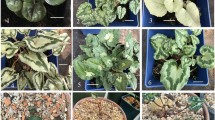Abstract
Stegnogramma pozoi (Lagasca) K. Iwats. subsp.mollissima (Fischer ex Kunze) K. Iwats. is one of the most common ferns in Japan with a very broad geographical distribution and habitat ranges. We examined the intrasubspecific variation of therbcL gene, and found three types in the subspecies (Atami-1, Atami-2, and Tateyama types). The Atami-1 and 2 types shared three apomorphic nucleotides and their geographical distribution is intermingled. Thus, we considered them to have intraspecific variation. In contrast, the Tateyama type had 4–5 different nucleotides than the Atami types, and showed a more northern distribution. Leaf morphology of the Tateyama type is distinct from that of the Atami types, though the leaf shape in Tateyama type varies considerably and in some cases overlaps with other types. Ferns have fewer morphological features that are systematically significant than flowering plants because they lack complex reproductive organ. It is reasonable to expect that species recognition of ferns based only on leaf morphology can be fine tuned by molecular features. Variation in therbcL sequences might be useful as an indication of significant biological units.
Similar content being viewed by others
References
Dewit, T.J., Sih, A. andWilson, A.S. 1998. Costs and limits of phenotypic plasticity. Trends Ecol. Evol.13: 77–81.
Doyle, J.J. andDoyle, J.L. 1987. A rapid DNA isolation procedure for small quantities of fresh leaf material. Phytochem. Bull.19: 11–15.
Felsentein, J. 1985. Confidence limits on phylogenies: An approach using the bootstrap. Evolution39: 783–791.
Haufler, C.H. andRanker, T.A. 1995.RbcL sequences provide phylogenetic insights among sister species of the fern genusPolypodium. Amer. Fern. J.85: 361–374.
Hauk, W.D. 1995. A molecular assessment of relationships among cryptic species ofBotrychium subgenusBotrychium (Ophioglossaceae). Amer. Fern. J.85: 375–394.
Hasebe M., Oumori, T., Nakazawa, M., Sano, T., Kato, M. andIwatsuki, K. 1994.RbcL gene sequences provide new evidence for the evolutionary lineages of leptosprangiate ferns. Proc. Natl. Acad. Sci. USA91: 5730–5734.
Hirabayashi, H. 1969. Chromosome numbers in several species of the Aspidiaceae. J. Jap. Bot.44: 113–119.
Hirabayashi, H. 1970. Chromosome numbers in several species of the Aspidiaceae (2). J. Jap. Bot.45: 45–52.
Iwatsuki, K. 1963. Taxonomic studies of Pteridophyta VII. Acta Phytotax. Geobot.19: 112–126.
Iwatsuki, K. 1995. Flora of Japan. Kodansha, Tokyo.
Kurita, S. 1960. Chromosome, numbers of some Japanese ferns. J. Jap. Bot.35: 269–272 (in Japanese with English summary).
Kurizono, S. 1987. Cytological studies on some taxa in thelypteroid ferns, Aspidiaceae. Kromosomo II46: 1513–1520.
Maddison, W.P. andMaddison, D.R. 1992. MacClade, Version 3.0. Sinauer Associates. Sunderland.
Manton I. andSledge, W.A. 1954. Observation on the cytology and taxonomy of the pteridophyte flora of Ceylon. Philos. Trans. Roy. Soc. London B238: 127–185.
Masuyama, S. 1992. Clinal variation of frond morphology and its adaptive implication in the fernCeratopteris thalictroides in Japan. Pl. Species Biol.7: 87–96.
Masuyama, S. andWatano, Y. 1994. Hybrid sterility between two isozymic types of the fernCeratopteris thalictroides in Japan. J. Plant Res.107: 269–274.
Mitui K. 1968. Chromosomes and speciation in fern. Sci. Rep. Tokyo Kyoiku Daigaku, Sec. B13: 285–333.
Murakami, N. 1995. Systematics and evolutionary biology of the fern genusHymenasplenium (Aspleniaceae). J. Plant Res.108: 257–268.
Phipps, C.J., Taylor, T.N., Taylor, E.L., Cuneo, N.R., Boucher, L.D. andYao, X. 1998.Osmuda (Osmundaceae) from the Triassic of Antarctica: an example of evolutionary stasis. Amer. J. Bot.85: 888–895.
Serizawa, S. 1983. On JapaneseStegnogramma pozoi subsp.mollissima. Bull. Jap. Pterid. Soc.56: 3–5 (in Japanese).
Swofford, D. 1993. Phylogenetic Analysis Using Parsimony, Version 3.1. Sinauer Associates, Sunderland.
Tagawa, M. 1959. Colored lllustrations of the Japanese Pteridophyta. Hoikusha, Osaka (in Japanese).
Templeton, A.R. 1989. The meaning of species and speciation: A genetic perspective.In D. Otto and J. A. Endler, eds., Speciation and Its Consequences, Sinauer Associates, Sunderland, pp. 3–27.
Watano, Y. andMasuyama, S. 1994. Genetic differentiation in populations of the polymorphic fernCeratopteris thalictroides in Japan. J. Plant Res.107: 139–146.
Author information
Authors and Affiliations
Rights and permissions
About this article
Cite this article
Yatabe, Y., Takamiya, M. & Murakami, N. Variation in therbcL sequence ofStegnogramma pozoi subsp.mollissima (Thelypteridaceae) in Japan. J. Plant Res. 111, 557–564 (1998). https://doi.org/10.1007/BF02507791
Received:
Accepted:
Issue Date:
DOI: https://doi.org/10.1007/BF02507791




